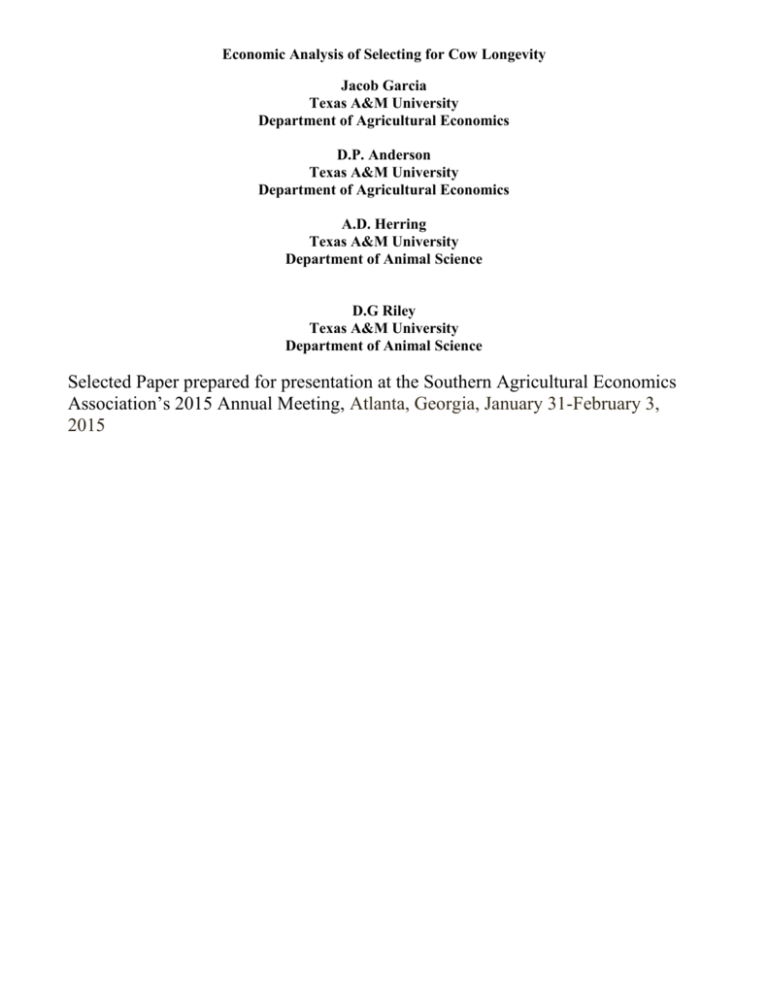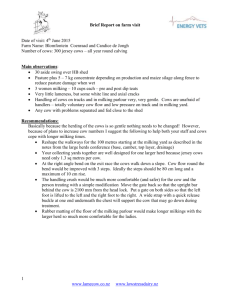Word - AgEcon Search
advertisement

Economic Analysis of Selecting for Cow Longevity Jacob Garcia Texas A&M University Department of Agricultural Economics D.P. Anderson Texas A&M University Department of Agricultural Economics A.D. Herring Texas A&M University Department of Animal Science D.G Riley Texas A&M University Department of Animal Science Selected Paper prepared for presentation at the Southern Agricultural Economics Association’s 2015 Annual Meeting, Atlanta, Georgia, January 31-February 3, 2015 Economic Analysis of Selecting for Cow Longevity Selecting for longevity and time length of peak cow performance contributes positively to cow-calf profitability. This paper examines the economic impact of selecting for cow longer longevity on returns. Data from a longevity project using Angus, Gray Brahman, Red Brahman, Indu-Brazil, Gir, and Nellore cattle from 1985 to 2005 were utilized to determine the economic impact of increasing the productive cow lifespan. Net present value was estimated for cows using a stochastic simulation model. Average NPV was the highest for the Nellore crossbreds and lowest for the Angus crossbreds. The value of inclusion of an additional year of peak performance ranged from $118 per cow for the Angus crossbreds to $244 per cow for Indu-Brazil sired cows. The economic impact of increasing longevity through selection or increasing the number of peak production years was positive. When age at culling was compared, it was found that Nellore and Gir crossbreds had means that were significantly larger than the base, Angus crossbreds. Selecting for longer productive cow life is shown to have a older optimal cow culling age. ABSTRACT: Introduction Longevity of cows can be defined as the length of time that a cow is productive. Longevity in beef production is based around avoidance of removal from the herd, which would primarily occur because of reproductive failure or the production of poor quality calves. Shafer (2006) stated that producers have long known that cow longevity is a major piece of the profitability puzzle. The value of longevity is affected by the opposite value of removal and the cost of replacement. The age of a beef cow’s peak performance and profitability is about 9 years of age. The optimal age of removal has been investigated from a production perspective, but there has not been adequate research on the economic impacts of increasing the productive life of the beef cow (Rogers, 1972; Tronstad et al., 1993; Ibendahl et al. 2004). Today, record high calf, cattle, and beef prices have pushed the costs of purchasing replacement cows and heifers to record high prices. Higher production costs have increased the costs of a ranch raising its own replacements. That has renewed interest in selecting cows, if possible, for longer productive life. This research also makes a contribution one further area and that is in breed. Past work has focused on English breeds mostly in the Northern Plains or northern areas of the U.S. This work uses a unique set of data to include the evaluation on Brahma and other Bos Indicus cattle. The objective of this research is to determine the economic impact of increasing the productive lifespan of a beef cow, and the economic gains from a longer peak productive life. Data and Methodology The data used in this study was collected from the Texas AgriLife Research station at McGregor, Texas. The cows used in this study were born from 1982 to 1985, and were F1 crosses. The dams of these F1 cows were purebred Hereford cows. Angus, Gray Brahman, Gir, Indu-Brazil, Nellore, and Red Brahman bulls were sires of the cows in the study. Paschal et al. (1991; 1995) reporte the birth and weaning characteristics of these cows and their half-siblings, and the stocker performance, feeder performance, and the carcass characteristics of the steers that were siblings to the F1 cows used in this study. Riley et al. (2001a, b) compared the differences in reproductive, maternal and size traits, udder characteristics, loss of incisors with aging, longevity, and lifetime productivity for the cows of these breedtypes. Cows were removed from the project after 2 failures to wean calves (from annual exposure to bulls) through 12 yr of age. Subsequently cows were removed after a single failure to wean a calf. Cows were removed at any time for severe udder problems, structural unsoundness, and health conditions. Net present value (NPV) is defined as the present value of the revenue minus costs over the investment period. NPV is commonly utilized to analyze the profitability of an investment. In this case, the investment is the cow. Revenues are generated from the calves sold and the salvage value of the cow. 𝑡 𝑁𝑃𝑉 = ∑ 𝑖=1 𝑅𝐸𝑉 − 𝐶𝑂𝑆𝑇 (1 + 𝑖)𝑡 Where: 𝑁𝑃𝑉 = net present value 𝑅𝐸𝑉 = cash inflows 𝐶𝑂𝑆𝑇= cash outflows 𝑖 = discount rate t = (cow age-2) The NPV is calculated on a per cow basis. The effect of a longer productive life or increased longevity is evaluated in terms of the difference in NPV. Stochastic simulation techniques, using Simetar, an Excel based simulation and risk analysis program, were used to account for variability in steer and heifer weaning weight and the weaning rate based on the variability observed in the cow data. Simulation provides the opportunity to make probabilistic estimates of alternative strategies based on the estimated distributions of economic returns. It was assumed that the cow would not incur the full costs associated with remaining in the herd for an additional year, during her final year. Therefore, the cost of maintaining the cow per year was not subtracted from the final year that she was alive in the herd. Average annual cow costs were estimated to be $600 (citation). The average weaning weight for steers and heifers were taken independent of each other for each year that a cow of a particular cross was in the study. Averages of the weights were taken for each dam age separated by sire of dam breed group. An OLS regression was run in order to predict the annual weights of the steers and heifers. The cows were bred to calve first at 2.5 yr of age. Therefore, all data begins at a dam age of 3 years. After first calving as 2.5 year olds the cows were subsequently bred to calve at 3.5 years and so on, until the end of the study. The model is a basic Net Present Value (NPV) model. It takes into account revenue and the cost associated with each cow in the herd. Revenue was determined by multiplying the probability a cow would calf a steer with the stochastic weight of a steer and the stochastic price of a steer for that particular year. This value was then added to the dollar amount generated by multiplying the probability of the cow having a heifer calf by the heifer price and stochastic heifer weight. An annual production cost of $600 per cow was assumed based on Standardized Performance Analysis records. The profit (loss) dollar amount was then discounted to its present value. The net present value for each year was summed up for each cow individually; this yielded the NPV for that particular cow. For the year that the cow was culled revenue was increased, if applicable, by multiplying her final weight with the stochastic price for a cull cow. If the cow died or was culled for reasons that would make her unfit for sale and slaughter, her value at culling was not included in the model. To determine the effect of one additional year of peak productivity, an additional year where the average NPV of the breed group was highest would be added again. This meant that if the average peak year for Angus cows was at age 6, then an additional year, using data from age 6 was added and discounted to the overall NPV of all Angus sired cows. Changes in dollar value from the beginning to the end of the study, as well as the differences in weaning rate and weaning weight across the different breeds utilized in the study. Weaning weights are correlated to the probability that the cow had either a bull or heifer calf during that particular year. The data for prices will be stochastic, so as to simulate the price changes from one year to the next. The weaning rates to be used in the study changed from year to year and were divided into individual rates based on the sire of dam breed and by the age of the cow. Results Weaning weights declined with age past peak production years. NPV became negative for each cow at some age when costs exceeded the revenue from the calf produced at that age. The age at which annual NPV became negative ranged from 11 for the Indu-Brazil crosses to 15 yr for the Nellore crosses (Table 1). Net Present Value for the Angus and Gray Brahman crossbred became negative on average at 12 and 13 yr of age, respectively. Average NPV was the highest for the Nellore crossbreds ($2,338) and lowest for the Angus crossbreds ($245). The NPV was affected strongly by the number of failures to wean a calf, the number of years calves were weaned, and the weights of the weaned calves. Nellore crossbreds had the longest productive life and weaning rate. The value of inclusion of an additional year of peak performance ranged from $118 per cow for the Angus crossbreds to $244 per cow for Indu-Brazil sired cows (Table 2). As expected, an additional peak year of production generated a positive economic return and increased cow value. Greater longevity and longer peak productivity generated increased value. Additional lines of inquiry include determination of optimal ages of removal for each breed , and identification of economically appropriate removal criteria for individual cows. Combining selection procedures with economic decision processes could strongly impact profitability. Literature Cited Ibendahl, G.A., J.D. Anderson, and L.H. Anderson. 2004. Deciding when to replace an open beef cow. Agricultural Finance Review. Vol?:61-74. Paschal, J.C., J.O. Sanders, and J.L. Kerr. 1991. Calving and weaning characteristics of Angus-, Gray Brahman-, Gir-, Indu-Brazil-, Nellore-, and Red Brahman-sired F1 calves. J. Anim. Sci. 69:2395-2402 Riley, D.G., J.O. Sanders, R.E. Knutson, and D.K. Lunt. 2001a. Comparison of F1 Bos indicus x Hereford cows in central Texas: I. Reproductive, maternal, and size traits. J. Anim. Sci. 79:14311438 Riley, D.G., J.O. Sanders, R.E. Knutson, and D.K. Lunt. 2001b. Comparison of F1 Bos indicus x Hereford cows in central Texas: II. Udder, mouth, longevity, and lifetime productivity. J. Anim. Sci. 79:1439-1449 Rogers, L.F. 1972. Economics of replacement rates in commercial beef herds. J. Anim. Sci. 34: 921-925. Shafer, W. 2006. Implementation of a Stayability EPD: American Simmental Association perspective. American Simmental Association. Vol:pages Tronstad, R., R. Gum, D. Ray, and R. Rice. 1993. Range cow culling: herd performance. Ranch Business Management. Vol: 27-32 Table 1. Average net present value of each sire of breed group (95% CI) Sire of Dam Breed N Average Age (yr) with 1st Negative NPV 15 12 Angus Total NPV $ 3,685.65 ($571.73, $7420.68) 21 13 Gray Brahman $ 20,642.83 ($16,513.65, $24,710.82) 15 15 Gir $ 27,937.92 ($23,720.85, $32,127.98) 19 11 Indu-Brazil $ 25,728.16 ($19,285.70, $30670.38) 25 15 Nellore $ 58,457.66 ($50,656.24, $64,830.53) 21 Red Brahman 13 $ 22,841.03 ($21,100.08, $24,580.54) Average NPV per Cow $ 245.71 (-$7.48, $491.21) $ 982.99 ($791.84, $1172.29) $ 1,862.53 ($1564.10, $2152.17) $ 1,354.11 ($990.21, $1610.38) $ 2,338.31 ($2025.08, $2593.10) $ 1,087.67 ($991.11, $1177.13) Table 2. Average net present value (NPV) of breed groups after inclusion of one additionala peak year (95% CI) Change in Average Average NPV per Cow NPV per Cow $ 363.69 $ 117.98 Angus ($62.78, $653.72) ($24.24, $203.48) 21 $ 19,980.45 $ 1,042.65 $ 59.66 Gray Brahman ($836.22, $1,231.74) (-$.10, $119.14) 15 $ 27,255.02 $ 2,082.25 $ 219.72 Gir ($1,738.17, $2,390.60) ($123.25, $294.30) ($26,192.46, $36,122.51) 19 $ 26,729.52 $ 1,598.95 $ 244.84 $ 30,830.13 Indu-Brazil ($1,207.95, $1,915.61) ($110.50, $340.39) ($22,998.71, $36,171.68) 25 $ 58,664.73 $ 2,578.15 $ 239.84 $ 64,453.67 Nellore ($2,242.88, $2,848.43) ($142.35, $311.45) ($55,944.13, $71,684.01) 21 $ 22,291.73 $ 1,269.71 $ 182.04 $ 26,663.99 Red Brahman ($1,162.95, $1,374.80) ($145.99, $219.23) ($24,788.37, $28,743.654) a. the additional year was chosen by picking the year where the average NPV of the breed group was highest, and using the data a second time, thereby adding one more additional year into the study Sire of Dam Breed N 15 Total Original NPV $ 5,278.49 NPV +1 Peak Productive Year $ 5,455.28 ($1,588.08, $9,667.35) $ 21,895.73 ($17,308.25, $26,803.08) $ 31,233.82





